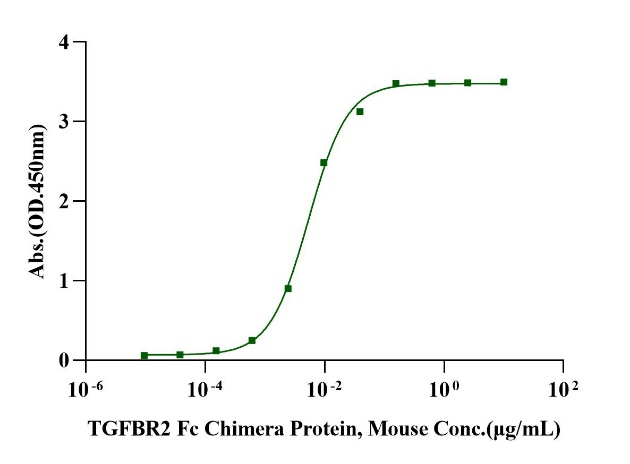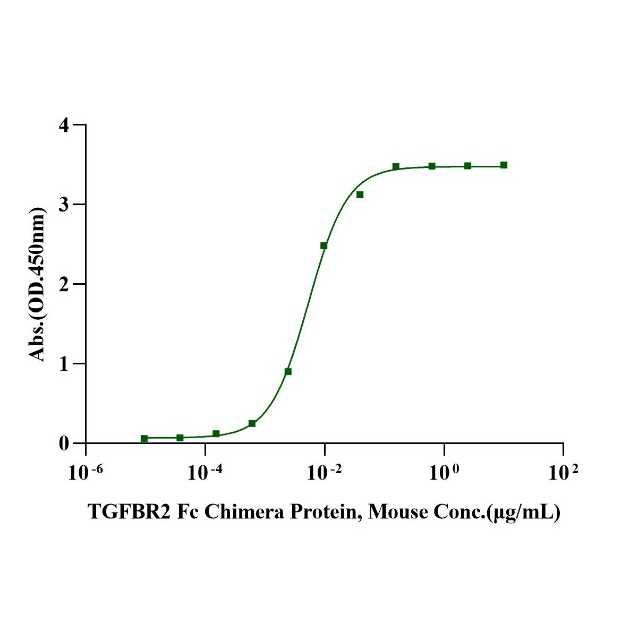Measured by its ability to inhibit the IL-4-dependent proliferation of HT‑2 mouse T cells. The EC50 for this effect is less than 1ng/mL after acid activation.
Product Details
Product Details
Product Specification
| Species | Mouse |
| Synonyms | Transforming growth factor beta-1 proprotein; Latent TGF-beta 1; Latent TGFB1; TGFB1; CED; DPD1; LAP; TGF-beta-1; TGFB; |
| Accession | P04202 |
| Amino Acid Sequence | Leu30-Ser390 |
| Expression System | HEK293 |
| Molecular Weight | 13 kDa & 35-55 kDa (Reducing) |
| Purity | >95% by SDS-PAGE and HPLC. |
| Endotoxin | <0.1EU/μg |
| Conjugation | Unconjugated |
| Tag | No Tag |
| Physical Appearance | Lyophilized Powder |
| Storage Buffer | 20mM PB, 150mM NaCl, pH7.0 |
| Reconstitution | Reconstitute at 0.1-1 mg/ml according to the size in ultrapure water after rapid centrifugation. |
| Stability & Storage | ·12 months from date of receipt, lyophilized powder stored at -20 to -80℃. |
| Reference | Proc Natl Acad Sci U S A. 2023 Nov 28;120(48): e2313228120. |
Background
Transforming growth factor-beta 1 (TGF-β1) is a critical cytokine that plays a pivotal role in a wide range of biological processes, including cell growth, differentiation, migration, apoptosis, and immune regulation. In mice, TGF-β1 is predominantly secreted in a latent form, which requires activation to exert its biological effects. The latent form of TGF-β1 (L-TGF-β1) is composed of the mature TGF-β1 molecule, the latency-associated peptide (LAP), and the latent TGF-β1-binding protein (LTBP). This complex structure ensures that TGF-β1 is stored in the extracellular matrix (ECM) and can be activated in response to specific cellular and mechanical cues.
The mechanical activation of latent TGF-β1 is a critical mechanism by which cells can modulate TGF-β1 signaling. Forces exerted on the latency-associated peptide (LAP) through integrins can lead to conformational changes in the latent complex, resulting in the release of active TGF-β1. This process is more efficient under conditions of higher cell forces and ECM stiffening, highlighting the importance of mechanical cues in TGF-β1 activation
Picture
Picture
Bioactivity
SDS-PAGE
2μg (R: reducing condition, N: non-reducing condition).
RP-HPLC
>95% as determined by RP-HPLC. Peak which RT=15.1min is mature dimer, while RT=16.6min is LAP dimer.
ELISA
Immobilized Latent TGF-β1 Protein, Mouse (Cat. No. UA040386) at 2.0μg/mL (100μL/well) can bind Biotinylated TGFBR2/TGF-beta RII Fc&Avi Tag Protein, Mouse (Cat. No. UA010847) with EC50 of 41.06-72.68ng/mL.

Immobilized Latent TGF-β1 Protein, Mouse (Cat. No. UA040386) at 2.0μg/mL (100μL/well) can bind TGFBR2 Fc Chimera Protein, Mouse (Cat. No. UA010646) with EC50 of 4.77-6.13ng/mL.


